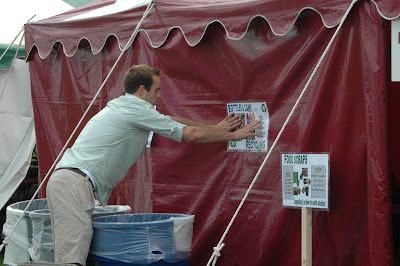
The relatively new company was founded in 1995 by the current President and Owner, Mike Whyte. RCR&R’s mission is to provide cost effective and safe environmental solutions for the disposal of outdated or broken technology products. Using their own version of the 3R’s, RCR&R focuses on 3 methods of disposal: Reuse, Recovery, and Recycling.
Our goal for this field trip was to acquire information for students and staff regarding eWaste and answer questions that could be brought up in the future.
Why should we recycle eWaste?
Electronic equipment contains metals and toxic materials that can be harmful to human health and the environment if they are not properly managed. If these technologies are disposed of in landfills then destructive metals such as Cadmium, Lead, and Mercury can be leached into the soil or burned and be released into the atmosphere.

What happens to our electronics after they are delivered to RCR&R?
Colgate's eWaste is picked up and dropped off at the RCR&R facility where it is processed, broken down, and sorted. RCR&R, then, either resells the equipment or recycles the unusable components by sending parts downstream to other companies that specialize in managing a specific component.
As a whole, eWaste has very little resell value due to the current technology boom. Many computers in the modern age become obsolete within two years, which makes reselling them at a cost effective price very difficult.

How does RCR&R ensure that the electronic parts they sell to the further de-manufacturers do not just end up in a landfill?
RCR&R personally audits the primary and secondary companies that it sends its recyclable components to, to make sure that the downstream businesses dispose of the electronic waste correctly.
How does RCR&R dispose of plastic waste?
Although there is a limited market for mixed plastics, RCR&R compacts all of the plastic it receives from monitor, computer, and television housings and sells it to outside vendors who reuse the plastic in their products.
If I decide to recycle my old computer, how does RCR&R provide me with data security?
All the circuit boards that RCR&R receives from computers or other electronic devices are personally put through a metal shredder that completely renders the circuit board useless. RCR&R also has the ability to wipe the memory of any circuit board they receive that erases all the data on the drive. These boards are still very likely to be placed in the shredder afterward.

How many pounds of eWaste does Colgate produce per year?
Between June 2008 and June 2010 Colgate produced 38,566 lbs. of electronic waste not including eWaste collected by the student body.
Also, the interval between May of 2008 to February of 2009 shows that Colgate forwards roughly 1,900 lbs of eWaste to RCR&R each month. This 1,900 lbs only includes devices purchased by the University.

How can we help recycle eWaste?
Colgate has created an electronic waste center at the COOP to help students sort and identify items that are considered “electronic waste.” This new centralized E-WASTE station at the COOP, between the dining center and the C-Store, simplifies the process of sorting, in hopes of increasing student compliance. Students and staff can recycle batteries (wrapped in tape), iPods, cameras, cellphones, CDs/DVDs, cables, ink cartridges, lightbulbs (wrapped in newspaper), and larger electronic equipment such as laptops or printers.
For more information visit the RCR&R website at www.eWASTE.com and for further questions about eWaste at Colgate email Colgate's Sustainability Coordinator, John Pumilio, at jpumilio@colgate.edu.













